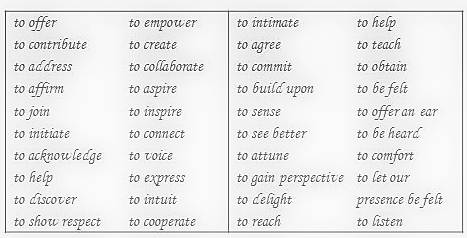 There is much made about Sheryl Sandberg’s book, Lean In. In fact, according to the New York Times, the word Lean In has become a meme.
There is much made about Sheryl Sandberg’s book, Lean In. In fact, according to the New York Times, the word Lean In has become a meme.
In it, we are told “don’t hold back” and “don’t pull back.”
Lean in.
We are also encouraged to remove our internal obstacles – to overcome the “battle from within”.
It’s about asserting yourself – man or woman. So when you find yourself in those “moments of truth”, how do you do it?
Let me tell you why – and how.
Recently, I saw an exhibit of artwork by the acclaimed Richard Serra called “Verb List” (1967–68) in pencil on two sheets of paper, the artist lists the infinitives of 84 verbs—to roll, to crease, to fold, to store, etc.—in four columns of script. (see above)
Know that to lean in is a verb. It’s a dynamic action – a dynamic intention.
Here, I’ve crafted my own Verb List for to Lean In. As people encouraging cultures of great potential, why we Lean In is important –

In the research and in my work I’ve come to know that specific physical movement can affect changes in our dominant emotions. Therefore, when you take this simple action, you can increase your confidence, presence and command in the room.
Let me show you how:
- Stand up, connect to breath, find your center, get grounded, lengthen, shift your weight forward and lean in – from the pelvis (not your waist)
- Try this sitting down. Sit on your sitz bones evenly, feet flat on the floor. Lengthen, shift your weight forward, and now lean in.
- Connect to the others at the table.
- Make sure you are breathing.
This connects you to greater impulse. The real you emerges forward.
Do you feel more confident? Good. Then speak. From this small, yet intent movement your voice is stronger too. You get yourself heard.
Next meeting, be at the table. Lean in. Contribute positively to the conversation. Our world may depend on it.
(For more information on Verb List by Richard Serra, go to http://www.moma.org/explore/inside_out/2011/10/20/to-collect )

